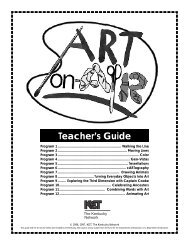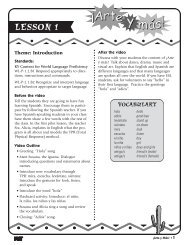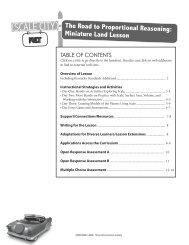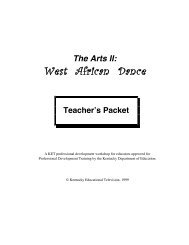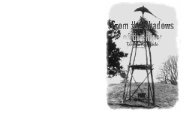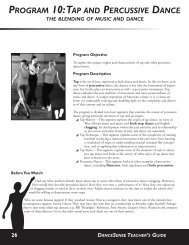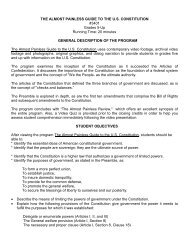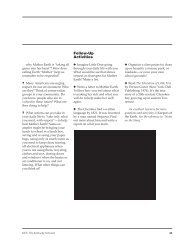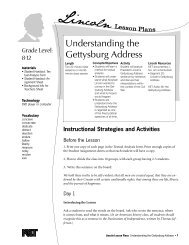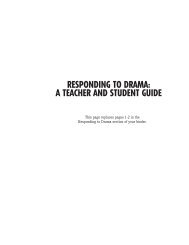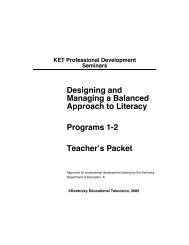7369 old music 2402 - KET
7369 old music 2402 - KET
7369 old music 2402 - KET
You also want an ePaper? Increase the reach of your titles
YUMPU automatically turns print PDFs into web optimized ePapers that Google loves.
appears to be descended from a<br />
German instrument called the<br />
Scheitholt, which was brought by<br />
immigrants in the 1700s.<br />
Knowledge of this instrument<br />
appears to have spread through the<br />
Scots-Irish population of the southern<br />
Appalachian range along with the<br />
desire to improve upon its limitations:<br />
very low volume and slow playability.<br />
The fingerboard was raised and the<br />
soundbox enlarged by these innovators,<br />
with different shapes for different<br />
regions, until the instrument we know<br />
as the dulcimer was born. John Jacob<br />
Niles and Jean Ritchie are credited with<br />
popularizing the use of dulcimers as<br />
accompaniment to English-language<br />
ballads and dance songs.<br />
Programs 2, 8, 10, 14<br />
fiddle<br />
Although the term fiddle is used<br />
colloquially for a particular member of<br />
the violin family, it is also a generic<br />
term for any lute-type instrument<br />
played with a bow. Since the late 18th<br />
century, the fiddle has been a prominent<br />
American folk instrument. In the<br />
South, the fiddle typically is tuned<br />
differently from the violin, and the<br />
playing tradition is British-influenced.<br />
The fiddle can be held against the chest<br />
as well as under the chin. Another<br />
example of how instruments move<br />
among <strong>music</strong>al traditions, the fiddle<br />
also can be found in Mexican mariachi<br />
bands.<br />
Programs 5, 7, 8, 9, 13<br />
guitar<br />
The guitar, a string instrument of the<br />
lute family that is either plucked or<br />
strummed, can be traced back to North<br />
Africa. It was introduced to white blues<br />
and folk <strong>music</strong>ians relatively late, about<br />
the turn of this century, mostly by<br />
African-American railroad crews.<br />
In Europe, the guitar can be traced to<br />
the Renaissance. The European version<br />
was originally a shorter instrument with<br />
four strings, which became five by the<br />
end of the 5th century in either France<br />
or Italy and finally six, creating the<br />
instrument we know today. During the<br />
20th century, many changes have been<br />
made to the basic design of the sixstring<br />
guitar to produce greater volume<br />
and distinct styles, including a<br />
“bassier” tone more suited for folk and<br />
blues, where the guitar’s role was to<br />
accompany the voice.<br />
Programs 4, 5, 6, 7, 8, 9, 11, 12, 13, 15<br />
hammer dulcimer<br />
The hammer dulcimer is a trapezoidal<br />
box with more than 100 strings that<br />
are played with two little mallets. The<br />
dulcimer dates back to 2000 B.C. and is<br />
the <strong>old</strong>est percussion instrument in the<br />
world. It is also the great-grandfather of<br />
the piano, because it introduced the<br />
idea of striking a string with a mallet.<br />
Originating with the people of the<br />
eastern Mediterranean, like the harp,<br />
the dulcimer is now found throughout<br />
the world as both a folk and classical<br />
instrument. The Persian santur, the<br />
Hungarian cimbalom, the Swiss and<br />
German Hackbrett, and the Chinese<br />
yangchyn are all variants of the<br />
hammer dulcimer.<br />
It arrived in the United States in the<br />
early 1600s, appearing in the ship<br />
quartermaster’s log for the Jamestown<br />
settlement in Virginia. By the mid-<br />
1800s, it was a popular parlor instrument;<br />
it was even s<strong>old</strong> in the Sears &<br />
Roebuck catalog at the turn of this<br />
century.<br />
Programs 1, 3, 16<br />
harmonica<br />
Popular in this country since its first<br />
production in Germany in the mid-<br />
1800s, this reed instrument is placed<br />
between the lips and played by blowing<br />
in and out while covering unwanted<br />
holes with the tongue. The harmonica<br />
became a popular instrument in the<br />
middle of the 1800s because factory<br />
production made it widely available<br />
and inexpensive. During the American<br />
Civil War, s<strong>old</strong>iers from both the North<br />
and South often played the harmonica.<br />
It has played an essential role in the<br />
American blues and folk tradition.<br />
Programs 4, 5, 12, 14<br />
jaw harp<br />
This mouth instrument, which dates<br />
back thousands of years, consists of a<br />
flexible tongue-like piece (a lamella)<br />
fixed at one end to a surrounding<br />
frame. The jaw harp has a variety of<br />
uses: In Southeast Asia, it is used as an<br />
artificial voice. In India, it is used to<br />
enrich the sound of a drum. Some<br />
players emphasize the rhythmic, gonglike<br />
<strong>music</strong>, while others emphasize<br />
melodic styles to provide dance <strong>music</strong>.<br />
It has also been popular in the United<br />
States, particularly prior to the 20th<br />
century.<br />
This instrument is also known as a<br />
jaw’s trump, a trump, or a Jew’s harp.<br />
Programs 5, 9, 14<br />
quills<br />
A bunch of bamboo sticks of varying<br />
lengths, open on one end and closed on<br />
the other, this African-American reed<br />
pipe is played singly or in groups. The<br />
term “quilling” refers to the tuning of<br />
train whistles to produce distinctive<br />
sounds in the early 20th century on the<br />
Illinois Central and other railway lines.<br />
Program 14<br />
Spoons<br />
Two spoons are held back to back in<br />
one hand and played “clackity-clack”<br />
between the thigh and the other hand.<br />
Program 16<br />
Trump<br />
See jaw harp.<br />
Programs 5, 9, 14<br />
60 Old Music for New Ears Teacher’s Guide



